I had heard for years that you can improve the condition of clay soil by drilling holes in a lawn. I didn’t believe it. I’m skeptical by nature. But I’m always ready to put something to the test if only to disprove a myth.
I may have been wrong about this one.
If you have been considering this unorthodox method of improving drainage in your yard, you will want to read this article and watch the video I’ve included showing the results of this two year study.
Does drilling holes in clay soil improve drainage? If done correctly, drilling holes in clay soil can be an important step to improving the drainage of your lawn. The holes help to accelerate the natural conditioning of the clay when appropriate organic matter is added as well as allowing water to drain through to better soil below.
Now I know that information on this topic is controversial. I realize that the subject is very polarizing with people standing firm on both ends of the spectrum swearing that their position is factual. Let’s put that aside for a second and focus on what really matters – whether or not it works.
Proof That Drilling Holes In Your Yard Works!
I’m not here to refute the soil “experts” about the science. Honestly, I’m not sure I understand it completely myself. I only know what the results have been in my lawn.
Before we begin, here is a picture showing the difference in grass growth between two sides of my backyard lawn. I had a large area of clay soil where grass was difficult to grow.
The right side was drilled, the left side was not. Otherwise, they were seeded and treated the same. What’s important to understand is that neither side had grass a couple of years ago. (the gray circle toward the back right is where we burned some scrap wood after a home improvement project).
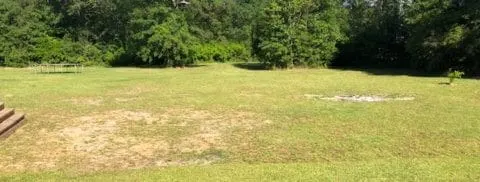
Theory is one thing but the evidence speaks for itself. By drilling a series of holes throughout my lawn and inserting organic matter and materials that create a friendly environment for worms and other beneficial organisms, soil conditioning is accelerated and new lawn growth thrives. In addition, drainage is improved as water is provided with a route through the heavy top layer of clay if there is better soil below.
Let’s look at why this happens and how you can use this approach to improve drainage and the condition of clay soil in your lawn.
Why Drilling Holes In Your Lawn Improves Soil
If you have read about, lawn aeration, composting, and creating worm bins then you understand the basic principles that are being used with this process.
You are essentially reducing compaction and replacing small sections of your soil with nutrient-rich matter. This matter breaks down encouraging beneficial microbes in your soil. As the matter decomposes, it’s nutrients are released into the ground.
Additionally, by drilling holes in your lawn and filling them with organic matter, you are encouraging earthworms to enter and begin breaking down the matter. The worms then move into the clay and deposit their castings, improving the condition of the nearby soil.
Why Drilling Holes In Your Lawn Improves Drainage
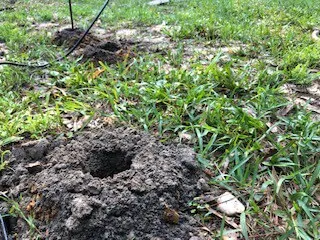
A great benefit to drilling holes in your yard and filling them with organic matter is that you are providing a way for water to drain. This is assuming that the soil below the top 12 inches of soil is of a better condition than the upper layer. If you have a problem with standing water in your yard, it is possible that you have a layer of clay that is preventing water from draining through to deeper soil.
In my front yard I noticed that I have about 6 inches of clay before I get to better soil. In parts of my backyard, however, there are areas that the clay goes down at least 2 feet, possibly more. There is no “good soil” to help the water drain down to. So does this process still improve drainage? The answer is yes, over time.
By drilling a series of holes in your lawn and filling it with organic matter, you are beginning the process of improving the overall condition of the soil. Repeat the process each year and over time you can dramatically improve it’s condition. As you do this, you are creating soil that allows for better drainage and absorption of water.
If you have an issue with standing water in your yard that requires immediate intervention, consider installing a french drain system. I installed french drains in my yard to stop standing water and in my flower bed to prevent water from pooling.
This is a closer view of both sections. You can see that where holes were drilled the grass is quickly growing in. Less so on the side that was not drilled.
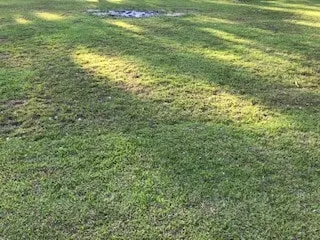
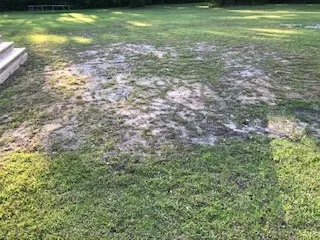
How To Improve Drainage and Soil By Drilling Holes In Your Lawn
I purchased a yard drill bit similar to this one on Amazon which attaches to a regular drill. It’s about 24 inches long and has a large boring coil on the end.
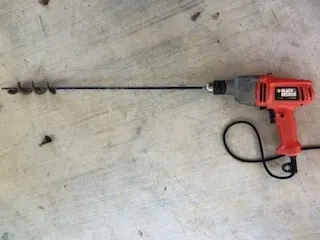
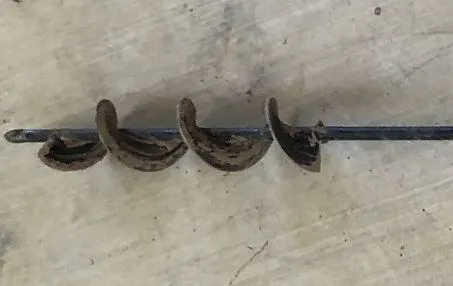
I didn’t scientifically measure distances between holes. Instead, I just randomly began drilling down through the soil here and there. What I ended up with was a haphazard pattern of holes throughout my yard.
It only takes a minute or so to drill a hole assuming the soil is soft. Harder soil may take a little longer but likely needs this done even more. I found that wetting the soil a little helped when working with hard, dried clay but not too much or it gets heavy and mushy.
One issue I ran into on occasion was roots. The bit does a pretty good job of tearing through smaller roots but it was no match for really large ones. When I ran into that issue I would just move a few inches and try again.
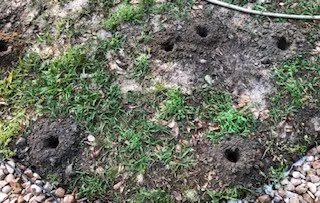
What To Put In The Holes To Improve Soil and Drainage
The great thing about this process is that there is no scientific formula to it really. You simply drill holes and fill them with organic matter. You can certainly geek out on how to do this but I tend to strive for “accidental perfection” with projects like this.
Once I have my holes drilled, I fill them with any organic matter that I have handy. Sometimes it’s grass clippings and leaves. Other times I’ll fill it with coffee grounds and vegetable left-overs. I’ll even use a paper towel, small sticks, peat moss, or pine straw. Whatever I have on hand that isn’t hazardous to my soil is game for this project.
Mix And Match Organic Matter For Improved Results
You can likely improve upon my results by being more purposeful in how you fill the holes. The ideas of layering organic matter in a lasagne-style approach is popular among composters. I do this in some of the holes but its more a matter of just happening to have multiple items on hand than strategic planning.
What I think is really important is that you are putting matter into the soil that breaks down, encourages worms and natural growth of beneficial microbes, and giving water someplace to go so that it doesn’t have to sit on your sod.
Add Pebbles To Improve Drainage Through Holes In Lawn
Another trick I learned was adding a generous number of small rocks and pebbles to some of the holes where water was standing. Because the pebbles do not fit together perfectly, air pockets are created where water can easily drain through.
Again, I am very haphazard in how I approach this. Sometimes I’ll drill a hole and fill it completely with pebbles. Other times I’ll mix in some organic matter. Occasionally I’ll put the organic matter in the bottom then fill with pebbles after that. I tend to believe that doing something is almost always better than doing nothing!
Paper Towel and Toilet Paper Rolls Keep The Hole Open
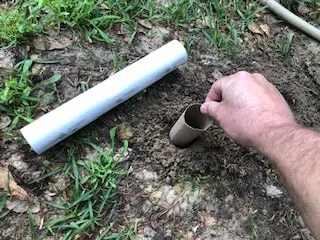
I ran across a little trick by accident. The holes created by my yard drill bit are just the right size to drop in a paper towel or toilet paper roll, depending on how deep I go. This keeps the pebbles or organic matter separate from the clay. Best of all, the roll will deteriorate naturally over time so that the soils can mix but it keeps them separate during the initial year as the organic matter is broken down.
This is not a required step but I do believe it is beneficial, especially when adding pebbles to facilitate drainage.
Below is another picture, this time with the soil that had holes drilled into it on the left side of the photo. The lawn directly behind the house has sod that was laid when we build the house but you can see the line where it stops and my grass growing efforts begin.
It’s not perfect by any means and there is still a lot of bare spots but there is no question that the side with holes drilled in it is coming along much better than the other side.
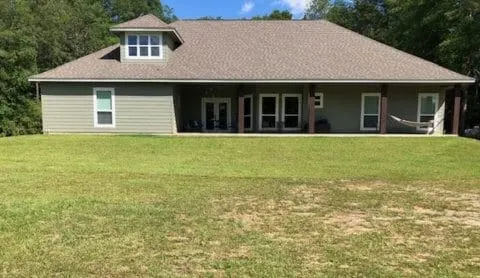
Conclusion
It’s clear to see that there are potential benefits to drilling holes in your lawn and filling them with pebbles and organic matter. What I want to encourage you to think about though is the long term benefits.
If you were to repeat this process each year, steadily drilling holes and filling them with nutrient rich matter and pebbles where drainage is needed, you could significantly improve the overall condition of your soil over the next few years and beyond.
As for me, I’m sold. I will being repeating this process for as long as my family lives here. Every year the soil will be a little better, the grass growth will improve a little more, and my lawn will be more lush.
And all of that from drilling holes in the lawn. My wife thought I was crazy. She still does. But she can’t argue with results. 🙂
If you want to start making improvements like this to your lawn, this yard soil drill bit is what you need to get started.
Related Articles:
How To Add Drainage To A Flower Bed (With Pictures!)
How To Stop Standing Water in Yard (With Pictures!)
As a homeowner, I am constantly experimenting with making the structure of my house more energy-efficient, eliminating pests, and taking on DIY home improvement projects. Over the past two decades, my family has rehabbed houses and contracted new home builds and I’ve learned a lot along the way. I share my hard-learned lessons so that you can save time and money by not repeating my mistakes.

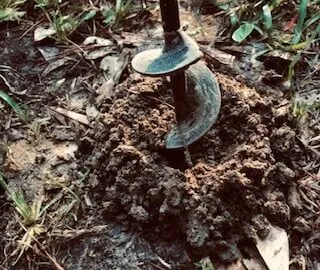
Leave a comment
You must be logged in to post a comment.